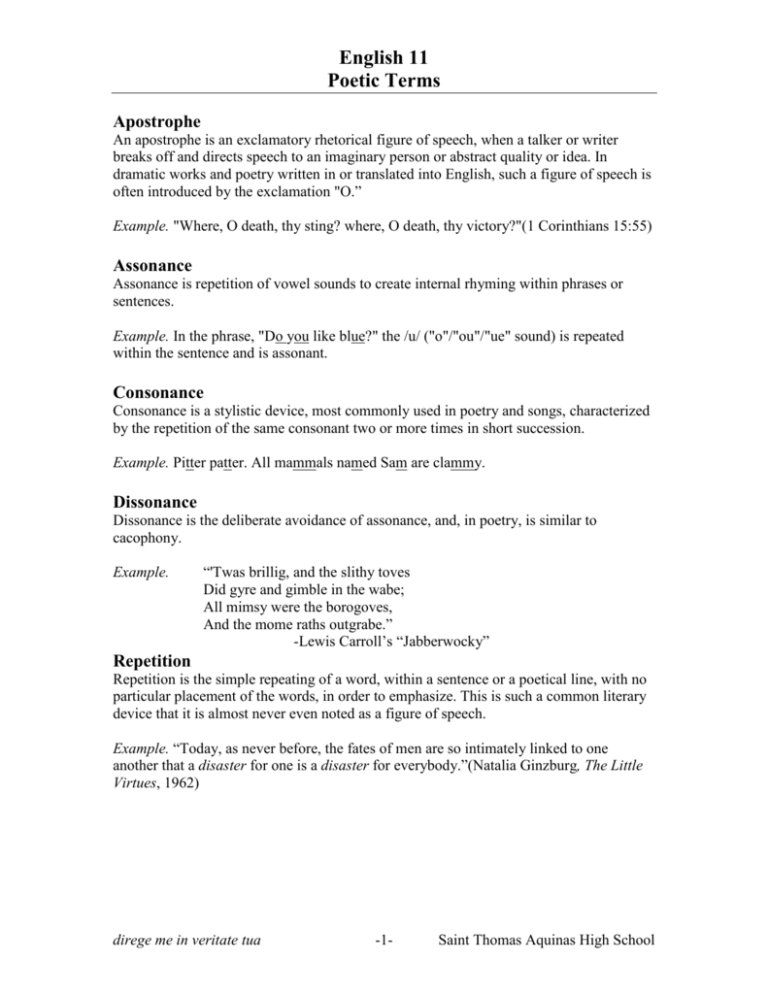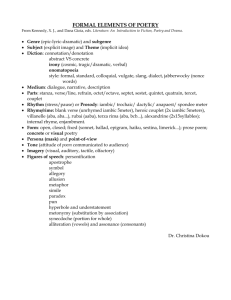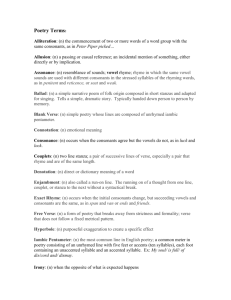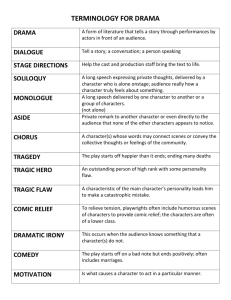English 11 Poetic Terms
advertisement

English 11 Poetic Terms Apostrophe An apostrophe is an exclamatory rhetorical figure of speech, when a talker or writer breaks off and directs speech to an imaginary person or abstract quality or idea. In dramatic works and poetry written in or translated into English, such a figure of speech is often introduced by the exclamation "O.” Example. "Where, O death, thy sting? where, O death, thy victory?"(1 Corinthians 15:55) Assonance Assonance is repetition of vowel sounds to create internal rhyming within phrases or sentences. Example. In the phrase, "Do you like blue?" the /u/ ("o"/"ou"/"ue" sound) is repeated within the sentence and is assonant. Consonance Consonance is a stylistic device, most commonly used in poetry and songs, characterized by the repetition of the same consonant two or more times in short succession. Example. Pitter patter. All mammals named Sam are clammy. Dissonance Dissonance is the deliberate avoidance of assonance, and, in poetry, is similar to cacophony. Example. “'Twas brillig, and the slithy toves Did gyre and gimble in the wabe; All mimsy were the borogoves, And the mome raths outgrabe.” -Lewis Carroll‟s “Jabberwocky” Repetition Repetition is the simple repeating of a word, within a sentence or a poetical line, with no particular placement of the words, in order to emphasize. This is such a common literary device that it is almost never even noted as a figure of speech. Example. “Today, as never before, the fates of men are so intimately linked to one another that a disaster for one is a disaster for everybody.”(Natalia Ginzburg, The Little Virtues, 1962) direge me in veritate tua -1- Saint Thomas Aquinas High School English 11 Poetic Terms Meter In poetry, the meter (or metre) is the basic rhythmic structure of a verse. Many traditional verse forms prescribe a specific verse meter, or a certain set of meters alternating in a particular order. Example. An important meter in English is the ballad meter, also called the "common meter,” which is a four line stanza, with two pairs of a line of iambic tetrameter followed by a line of iambic trimeter; the rhymes usually fall on the lines of trimeter, although in many instances the tetrameter also rhymes. “Amazing Grace! how sweet the sound That saved a wretch like me; I once was lost, but now am found; Was blind, but now I see.” (-John Newton) Iambic Pentameter Iambic pentameter is one of many meters used in poetry and drama. It describes a particular rhythm that the words establish in each line. That rhythm is measured in small groups of syllables; these small groups of syllables are called "feet.” The word "iambic" describes the type of foot that is used. The word "pentameter" indicates that a line has five of these "feet.” An iambic foot is an unstressed syllable followed by a stressed syllable. The rhythm can be written as: da DUM A line of iambic pentameter is five iambic feet in a row: da DUM da DUM da DUM da DUM da DUM It's possible to notate this with a '˘'(Breve) mark representing an unstressed syllable and a '/'(Forward Slash) mark representing a stressed syllable. In this notation a line of iambic pentameter would look like this: ˘ / ˘ / ˘ / ˘ / ˘ / Example: John Keats' “Ode to Autumn” “To swell the gourd, and plump the hazel shells” ˘ / ˘ / ˘ / ˘ / To swell the gourd, and plump the ha- direge me in veritate tua -2- ˘ / zel shells Saint Thomas Aquinas High School English 11 Poetic Terms Ballad Stanza Ballad Stanza is the four-line stanza, known as a quatrain, most often found in the folk ballad. This form consists of alternating four- and three-stress lines. Usually, only the second and fourth lines rhyme (in an a/b/c/b pattern). Assonance in place of rhyme is also common. Example. “The King sits in Dumferline Town, Drinking the blood-red wine: „O where will I get a good sailor to sail this ship of mine?‟” -anonymous Couplet A couplet is a pair of lines of verse. It usually consists of two lines that rhyme and have the same meter. While traditionally couplets rhyme, not all do. Example. “True wit is nature to advantage dress'd; What oft was thought, but ne'er so well express'd.” -Alexander Pope Elegy An elegy is a mournful, melancholic or plaintive poem, especially a funeral song or a lament for the dead. Example. “O Captain! my Captain! our fearful trip is done, The ship has weathered every rack, the prize we sought is won, The port is near, the bells I hear, the people all exulting, While follow eyes the steady keel, the vessel grim and daring; But O heart! heart! heart! O the bleeding drops of red, Where on the deck my Captain lies, Fallen cold and dead.” -Walt Whitman Ode An ode is a form of stately and elaborate lyrical verse that expresses personal feelings and often rhymes. It can also often be characterized by a title containing the word, “Ode.” Example. John Keats wrote “Ode to a Nightingale,” “Ode on Melancholy,” “Ode on a Grecian Urn,” “Ode to Psyche,” and “Ode to Autumn.” Quatrain A quatrain is a stanza consisting of four lines. direge me in veritate tua -3- Saint Thomas Aquinas High School English 11 Poetic Terms Octave An octave is a verse form consisting of eight lines of iambic pentameter (in English). The most common rhyme scheme for an octave is abba abba. An octave is the first part of a Petrarchan sonnet, which ends with a contrasting sestet. In traditional Italian sonnets the octave always ends with a conclusion of one idea, giving way to another idea in the sestet. Example. In Christina Rosetti‟s Sonnet “Remember,” her Octave is about remembering her, no matter what, when she is gone. Remember me when I am gone away, Gone far away into the silent land; When you can no more hold me by the hand, Nor I half turn to go yet turning stay. Remember me when no more, day by day, You tell me of our future that you plann'd: Only remember me; you understand It will be late to counsel then or pray. Yet if you should forget me for a while And afterwards remember, do not grieve: For if the darkness and corruption leave A vestige of the thoughts that once I had, Better by far you should forget and smile Than that you should remember and be sad. - Christina Rosetti Sestet A sestet is the name given to the second division of an Italian sonnet (as opposed to an English or Spenserian Sonnet), which must consist of an octave, of eight lines, succeeded by a sestet, of six lines. A sestet is also six lines of poetry forming a stanza or complete poem. Example. Rosetti‟s Sestet in the above mentioned Sonnet begins with the lines, “Yet if you should forget me for a while/ And afterwards remember, do not grieve:” (9-10). This illustrates a change in Rosetti‟s tone, who is now saying that she does not want to be remembered if it causes the person remembering pain. The above definitions related to poetry are examinable in English 11. These definitions were gathered from public domain content at wikipedia.org, dictionary.com, for students in the Saint Thomas Aquinas High School English Department. Poetic language could be used in any communication resembling poetry in beauty or the evocation of feeling. While these terms will be used in the study of poetry, they could be applied in any written or verbal expression. direge me in veritate tua -4- Saint Thomas Aquinas High School English 11 Poetic Terms Alliteration Imagery Metaphor Oxymoron Onomatopoeia Paradox Personification Symbol; symbolism Rhyme Theme Rhyme Scheme Atmosphere Rhythm Ballad Simile Blank Verse Speaker Free Verse Allusion Lyric Figurative Language Mood Hyperbole Refrain Image Sonnet Stanza Tone The above list constitutes the terms related to poetry that are have been covered in high school English and are examinable in English 11. direge me in veritate tua -5- Saint Thomas Aquinas High School







![iambic-pentameter-powerpoint[1]](http://s2.studylib.net/store/data/005389283_1-88464eb62969318d407043f4e7784268-300x300.png)
